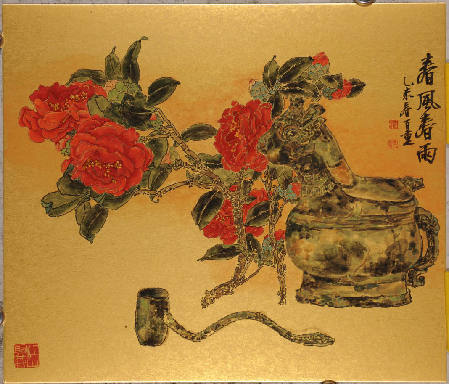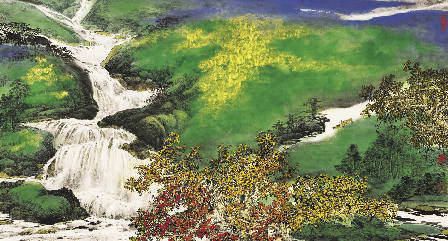Zheng Baizhong: Gazing at Landscapes
By staff reporter ZHANG HONG
ZHENG Baizhong is a distinguished master of contemporary Chinese landscape painting. Compared with traditional landscape paintings, Zheng Baizhong’s works capture the revolutionary transformations and realities of the 20th century. Zheng extends the boundaries of landscape painting in his depictions of the spectacular sceneries of Northwest and Southwest China – magnificent mountains, rapid waterfalls, lush forests, flourishing summers, and colorful autumns.
 |
| Spring. |
Acknowledged by Exotic Cultures
In his early years, Zheng Baizhong studied ancient Chinese prose with the help of his family, and learned painting and seal carving from Chen Zifen, a master of traditional Chinese painting. Later, he also learned landscape painting from renowned painter Chen Ting. His art style has inherited the essence of both his mentors.
In the 1980s, Zheng Baizhong held personal art exhibitions in several cities including Nanjing and Hangzhou. His works were admired by numerous prestigious experts, such as Lin Sanzhi, Qian Songyan, Lu Yanshao, Wei Zixi, Chen Dayu, Yang Jianhou, and Zhou Changgu.
Zheng Baizhong’s paintings are mostly based on well-known verses and odes written by famous Chinese literary figures such as Du Fu, Su Shi, and Fan Zhongyan. His work displaying Li Shangyin’s poem written on a rainy night was selected for an exhibition in Tokyo as one of the most remarkable calligraphy and painting works by modern Chinese artists.
In China, Zheng Baizhong completed his studies and established his own ideological system of landscape painting aesthetics. He lived in the U.S. for more than 10 years, becoming a representative artist of traditional Chinese painting living abroad.
He perceived his life overseas as having broadened his horizons, and encouraged him to explore Chinese culture from a different perspective. From the other side of the world, Zheng Baizhong saw his national culture and the value of cultural identity more profoundly than when he lived in China. Zheng never yields to cultural homogenization in the field of post-modern art. With a distinct spirit that runs through his blood and a unique perspective on the tip of his brush, his works are acknowledged and favored by exotic cultures.
Shao Dazhen, a professor at the China Central Academy of Fine Arts, considers Zheng Baizhong’s works as a mixture of skills in realism, brush handling, and traditional Chinese ink wash painting, with a Western influence.
“In an aesthetic sense, his paintings are bright and clear, showing and perfectly fusing the essence of both Chinese and Western painting skills. Zheng Baizhong is just who he is – shaped by his education, life experiences, and artistic exploration.”
Shao added that among the Western exponents of Chinese painting, few could be as dedicated and skilled in traditional brushworks as Zheng Baizhong.
Wherever he holds art exhibitions, Zheng Baizhong endeavors to spread the cultural gene of the Chinese through his traditional ink wash paintings.
 |
| Greening Wulingyuan |
Reviving the Past for the Present, Borrowing from the West
In comparison with stark, minimalistic landscape paintings, Zheng Baizhong’s works seem more elaborate and majestic. His pictures are scrolls of a magnificent nature – sublime but familiar. Instead of depicting exquisite bridges and rivulets in the regions south of the Yangtze River and mist over the Lijiang River in Guangxi, Zheng focuses on the canyons in Sichuan and Tibet, forests in Yunnan and Guizhou, prairies in Inner Mongolia, and plains of Hebei. He portrays deserted rocks and steep bluffs in The Golden Palace, precipitous cliffs and rapid waves in Song of the Yarlung Zangbo River, the overhead galaxy and waterfall torrent in Streaming down from Heaven, and luxuriant woods and an idyllic wonderland in Greening Wulingyuan.
Zheng Baizhong has gone through two important stages in his artistic creation. From the late 1970s to the late 1980s, his bird-and-flower paintings and landscape paintings developed simultaneously. By inheriting Chen Zifen and Lu Yanshao’s styles, he traced the origins of traditional Chinese painting, all the while striving for innovation against the backdrop of so-called “endangered Chinese painting” in the mid to late 1980s.
During this stage, Zheng Baizhong diligently practiced different schools of Chinese brushwork to gain a deeper understanding of the spirits and styles. At the same time, he tried to revive the past and borrow Western styles for Chinese paintings. Over a decade, his innovation made a fresh impression on China’s art circle. His works such as Birds and Flowers of the Four Seasons, A Long History, Widespread Fragrance and Man Can Conquer Nature stood out in terms of subjective creation and showcased a modern way of formation. Despite his adherence to the most traditional ink and brush techniques, Zheng’s innovative concept played a leading role in his works during this period.
The second stage dates back to the 1990s, when he went to lecture in the U.S. During this period, he also traveled to France, the U.K., Germany, Taiwan, Hong Kong, and Singapore to teach and hold exhibitions. The context of cultural heterogeneity was a constant reminder of the reasonability of artistic life. During that period, he steered clear of fashionable art, intentional sensationalism, and the disturbances of contemporary Western art. Returning to Chinese tradition, he found his own art style maturing.
Distinct Art Language
“To learn from tradition does not mean simply copying old styles. It requires balance and selection, so as to express a mood or a feeling.” Xue Yongnian, a professor at the China Central Academy of Fine Arts, believes Zheng Baizhong’s explorations of Chinese painting, line drawing, and coloring reveal solid groundwork.
Zheng Baizhong prefers to frame waterfalls pouring out of the sky, to structure cliffs and mists in canyons, to color green fields, forests and sheep. By using themes that are uncommon in traditional landscape paintings, he rewrites the landscape realm in pursuit of sublime beauty, which is almost absent from the aesthetics of traditional Chinese paintings.
Liu Xilin, a researcher at the National Art Museum of China, attributes Zheng Baizhong’s accomplishment to his profound cultural background – not the Min style, which prevailed in Fujian Province in southeastern China, but a foundation of overall awareness of Chinese civilization inherited from his mentors.
“He wrote about art history and discussed the relationship between Zen and Chinese calligraphy at symposiums in Taiwan, revealing his systematic knowledge of Chinese calligraphy and art history, which is an essential factor in his artistic achievement today.”
There have been very few masterpieces of traditional landscape painting since Zhang Daqian. According to Liu Xilin, Zheng Baizhong not only inherits this ability, but steps further by absorbing color techniques and some Western painting elements. “In this sense, he has positioned his landscape paintings in an ancient Chinese cultural ideal.”
Different from the paintings executed in a casual and indulgent way, Zheng Baizhong’s landscape painting seems more elaborate and unaffected. Instead of fabricating, piecing or simply copying, he infuses profundity in his landscape painting by refining and summarizing based on sketching.
Cheng Dali, editor-in-chief at the People’s Fine Arts Publishing House, believes that Zheng Baizhong has an incredible insight into the modern world, giving his work a unique art language with a personal style.
Unique Literati Painting of the Time
Zheng Baizhong has avoided traditional literati paintings, as demonstrated in his attitude towards life and society, his personality, and even the nature of his works. However, from the perspective of Westerners or in the context of post-modern art, his landscape painting still implies profound cultural characteristics, which makes it different from other overseas Chinese painters.
In a sense, it is the cultural connotation in Zheng Baizhong’s works that enhances his creative quality, unifying the contradictions between brushwork and layouts, ink and colors. The teaching experience in Zheng Baizhong’s résumé is quite impressive. From art academies in Fujian Province to the University of Iowa and the University of California, from the National Central University to National Taiwan Normal University, teaching Chinese art history has always been his major occupation.
As a scholar on art history, he has published several influential papers such as Buddhism and Chinese Calligraphy and Painting, Art of the “Eight Eccentric Painters of Yangzhou,” and Art and Calligraphy in the Bronze Age, showing his unique historical vision.
Ancient literati paintings often contain a rich cultural ethos and connotation. In this sense, Zheng Baizhong’s works are undoubtedly the literati paintings of the contemporary age. Especially when they are paralleled with post-modern works, Zheng Baizhong’s paintings present a stronger cultural ethos.
So far, Zheng Baizhong has held solo exhibitions in major cities on China’s mainland, Hong Kong, Taiwan, Singapore, Japan, the U.S., Canada, the U.K., France, and Italy. His paintings are collected by China’s Ministry of Culture, the National Art Museum of China, China Academy of Art, Kaohsiung Cultural Center in Taiwan, China Cultural Center in Paris, and museums and universities in the U.S. He has won various art awards in China’s mainland, Hong Kong, Taiwan, Japan, and the U.S.
It is the perspective owned by an art history scholar that endows Zheng Baizhong’s artistic creation significance and value of traditional literati painting in this contemporary age. It is also the cultural spirit and connotation in his works that reflect the national character and identity of Chinese culture.
